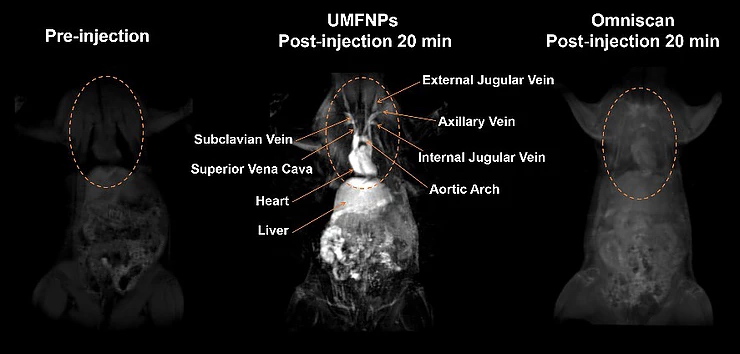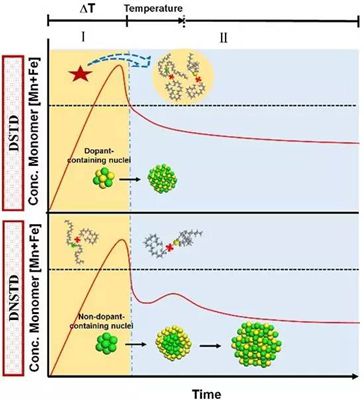Ultrasmall Ferrite Nanoparticles T1 Contrast Agent: High-Performance T1 Magnetic Resonance Imaging of the Blood Vessels and Liver
Magnetic ferrite nanoparticles with superior size/composition-tunable properties and good biocompatibility have been widely used in biomedical field. Recent advances in this field have revealed that the ultrasmall magnetite nanoparticles with sizes smaller than 5 nm can exhibit remarkable and counterintuitive T1 MR enhancement due to the strong size-related effects, in stark contrast to the conventional superparamagnetic iron oxide-based contrast agent (CA) such as Feridex, which is the representative T2 contrast agent. Despite its apparent advantages over the commercial gadolinium-based T1 MRI contrast agent, results from currently available ultrasmall ferrite nanoparticle-based T1 MRI probes have not been optimal. However, synthesis of ultrasmall metal ferrite nanoparticles with well-controlled size and composition simultaneously remains a challenging task due to the complex dynamic nature of the nucleation and growth process in the multicomponent system.

Recently, Prof. Hai Ming Fan’s group have developed a general dynamic simultaneous thermal decomposition (DSTD) strategy for controllable synthesis of monodisperse ultrasmall metal ferrite nanoparticles with sizes smaller than 4 nm. Taking ultrasmall MnFe2O4 nanoparticles (UMFNPs) as a model system, the synthesized UMFNPs exhibited the highest r1 relaxivity (up to 8.43 mM−1 s−1) among the ferrite nanoparticles with similar sizes reported so far and demonstrated a multifunctional T1 MR nanoprobe for in vivo high-resolution blood pool and liver-specific MRI simultaneously.
The new inexpensive and non-toxic iron-eruciate complex was paired with a metal-oleate complex as the precursors to attain DSTD synthesis. The comparison study revealed that the DSTD facilitated a nucleation-doping process, which is crucial for particle size and distribution control of ultrasmall ferrite magnetic nanoparticles, while the dynamic nonsimultaneous thermal decomposition (DNSTD) in the same conditions prevented effective nucleation and growth separation, resulting in nonuniform nanoparticles.

In terms of the boundary condition associated with a high magnetic field, the outer-sphere mechanism is usually assumed to dominate proton relaxation for superparamagnetic nanoparticle-based contrast agent systems, while the contribution from the inner-sphere mechanism is omitted. For the UMFNPs, the artificial Mn2+ doping in ultrasmall iron oxide nanoparticles could effectively expedite spin−lattice relaxation and increase inner-sphere contribution by altering the residence lifetime of the bound water. The prominent vascular details including the external jugular vein, axillary vein, internal jugular vein, subclavian vein, superior vena cava, and aortic arch can be distinctly distinguished in the T1-weighted MR images after the injection of the UMFNPs. Since the Mn2+ ion can be selectively taken up by hepatocytes via the vitamin B6 transporter, it is reasonable to assume that the UMFNP is a hepatocyte-specific contrast agent, which is different from the traditional superparamagnetic nanoparticle-based contrast agent by selective uptake and accumulation in the reticuloendothelial cells in the liver. Due to their small hydrodynamic size, 30.33% of the UMFNPs was excreted from the body via the renal clearance pathway and 67.40% of UMFNPs were excreted via the hepatobiliary pathway of the UMFNPs were excreted within 60 h. The rapid excretion of the UMFNPs within 60 h is of value to minimize systematic toxicity.

In summary, this work offers possibilities for the chemical design of a highly sensitive ultrasmall magnetic nanoparticle based T1 MRI probe for various clinical diagnosis applications.
Authors:Huan Zhang, Li Li, Xiao Li Liu, Ju Jiao, Cheng-Teng Ng, Jia Bao Yi, Yan E Luo, Boon-Huat Bay, Ling Yun Zhao, Ming Li Peng, Ning Gu, and Hai Ming Fan*.
Title:Ultrasmall Ferrite Nanoparticles Synthesized via Dynamic Simultaneous Thermal Decomposition for High-Performance and Multifunctional T1 Magnetic Resonance Imaging Contrast Agent.
Link:http://pubs.acs.org/doi/abs/10.1021/acsnano.6b07684.
 简体中文
简体中文 English
English
